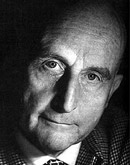

Werner March
*17. 1. 1894 – Berlin, Germany
†11. 1. 1976 – Berlin, Germany
Biography
Werner Julius March was born on January 17, 1894, in Charlottenburg into a prominent manufacturing and architectural family. His father Otto March was a significant Berlin architect and the designer of the German Stadium (1912-13), the predecessor of the Berlin Olympic Stadium. After graduating from high school in Charlottenburg (1912), March studied architecture at the Technical University in Dresden. From 1914 to 1918, he served as a soldier and completed his architecture studies at the Technical University in Berlin. He began his career as a site manager for the Imperial Compensation Administration (Oranienstrasse, Berlin-Kreuzberg) and was an apprentice to German J. Bestelmeyer. After passing the construction exams in 1922, he became independent. Together with his brother Walter (1900-69), he designed the German Sports Forum building (1926) in Berlin and, in the early 1930s, the House of German Sports. In 1928, he proposed a spatial restructuring of the sports complex designed by his father, the Grunewald Stadium. Based on these references, in 1932, he was commissioned for the project to organize the eleventh Olympic Games. The Imperial Sports Complex consisted of the Olympic Stadium - significantly altered due to Hitler's objections to the original project - a swimming stadium, and a forest grandstand.
The realization of this impressive structure brought additional orders for sports facilities, the implementation of which was hindered by World War II. Ultimately, of all the sports buildings, only the stadium in Cairo (1956) was constructed. March's project for an archaeological museum in Baghdad from 1936 was realized only in 1952-56. During World War II (1940-45), March served as a staff officer in the counterintelligence section under Admiral Canaris.
After the war, March was tasked with the reconstruction of the Mindener Dome and the town hall. In 1952, he designed the Protestant St. Peter's Church, and in 1961, the Lord's Prayer Church in Berlin-Wilmersdorf, which are among the particularly successful church buildings from the post-war period. From 1963 to 1967, the Institute for Communication Technology was established in the northern part of the TU Berlin campus. Of his few residential buildings, the most noteworthy is the Rechsbanksiedlung colony (1923) in Berlin-Wilmersdorf.
In October 1953, March became a professor of urbanism at TU Berlin and the director of the Central Institute for City Building. This institute became a venue for lectures by many international experts in urbanism, architecture, politics, and other fields. He successfully relocated the Federal Urban Institute to Berlin, making Berlin the center of urban planning. March retired in 1960. In addition to several built houses, his studio produced remarkable projects, such as the Munich Olympic Stadium, that remained unexecuted.
March had a significant influence on the current form of the competitive rules for the BDA architects, as well as in the international context when assessing the work of architects within UNESCO. It is a shame that his project to reconstruct Kreuzberg, on which he collaborated with sociologist Ilse Balg since 1963, was not realized.
In 1962, March was appointed an honorary senator of the Berlin University of Technology. He died in Berlin on January 11, 1976.
The realization of this impressive structure brought additional orders for sports facilities, the implementation of which was hindered by World War II. Ultimately, of all the sports buildings, only the stadium in Cairo (1956) was constructed. March's project for an archaeological museum in Baghdad from 1936 was realized only in 1952-56. During World War II (1940-45), March served as a staff officer in the counterintelligence section under Admiral Canaris.
After the war, March was tasked with the reconstruction of the Mindener Dome and the town hall. In 1952, he designed the Protestant St. Peter's Church, and in 1961, the Lord's Prayer Church in Berlin-Wilmersdorf, which are among the particularly successful church buildings from the post-war period. From 1963 to 1967, the Institute for Communication Technology was established in the northern part of the TU Berlin campus. Of his few residential buildings, the most noteworthy is the Rechsbanksiedlung colony (1923) in Berlin-Wilmersdorf.
In October 1953, March became a professor of urbanism at TU Berlin and the director of the Central Institute for City Building. This institute became a venue for lectures by many international experts in urbanism, architecture, politics, and other fields. He successfully relocated the Federal Urban Institute to Berlin, making Berlin the center of urban planning. March retired in 1960. In addition to several built houses, his studio produced remarkable projects, such as the Munich Olympic Stadium, that remained unexecuted.
March had a significant influence on the current form of the competitive rules for the BDA architects, as well as in the international context when assessing the work of architects within UNESCO. It is a shame that his project to reconstruct Kreuzberg, on which he collaborated with sociologist Ilse Balg since 1963, was not realized.
In 1962, March was appointed an honorary senator of the Berlin University of Technology. He died in Berlin on January 11, 1976.
The English translation is powered by AI tool. Switch to Czech to view the original text source.
Realizations and projects
Other buildings
Unrealized competition proposal for the Olympic stadium in Munich, 1965Renovation of the Berlin district of Kreuzberg (co. Ilse Balg), 1962-67
Church of the Lord's Prayer, Berlin-Wilmersdorf, 1961
St. Peter's Church, Bielefeld, 1954
Ancient Museum in Baghdad, Iraq, 1952-56
Apostolic Church in Gütersloh, 1951-52
Reconstruction of the provincial house in Münster, 1948-51
Reconstruction of the town hall in Minden, 1948-54
Reconstruction of the cathedral in Minden, 1946-57
Embassy of the Kingdom of Yugoslavia, Berlin-Tiergarten, 1938-39
Directorate of Hydraulic Works, Berliner Strasse, Potsdam, 1938-39
Forest Stand, Berlin-Ruhleben, 1934-36
Olympic Village (co. Watler March, H. Wiepking-Jürgensmann, G.Steinmetz), Dallgow-Döberitz, 1934-36
Carinhall - hunting lodge for Hermann Göring, Schorfheide, 1933 (burnt down in 1937)
German Sports Forum, Berlin-Westend, 1926-36











